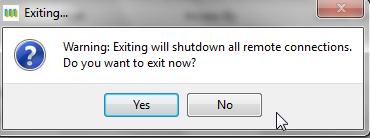Client Session Basics
The TotalView Remote Display Client is simple to use. Just enter the required information, and the Client does the rest.
On Linux, invoke the Client with the following:
remote_display_client.sh
On Windows, either click the desktop icon or use the TVT Remote Display item in the start menu to launch the remote display dialog.
The Client window displays similarly on Linux or Windows.
Here are the basic steps:
1 Enter the Remote Host
 Remote Host:
Remote Host: The name of the machine upon which TotalView will execute. While the Client can execute only on specified systems (see
Remote Display Supported Platforms), the remote system can be any system upon which you are licensed to run TotalView.
 User Name
User Name dropdown
: Your user name, a public key file, or other
ssh options.
2 (Optional) As needed, enter hosts in access order...(depending on your network).
3 Enter settings for the debug session on the Remote Host
Settings required to start TotalView on the remote host. (The TotalView and MemoryScape tabs are identical.)
 Path to TotalView on the Remote Host:
Path to TotalView on the Remote Host: The directory on the remote host in which TotalView resides, using either an absolute or relative path. “Relative” means relative to your home directory.
 (Optional) Your Executable:
(Optional) Your Executable: Either a complete or relative pathname to the program being debugged. If you leave this empty, TotalView begins executing as if you had just typed
totalview on the remote host.
 Other options
Other options:
You can add any command-line options for TotalView or your program.
TotalView options are described in the “TotalView Debugger Command Syntax” chapter of the TotalView Reference Guide.
For arguments to your program, enter them in the same way as you would using the -a command-line option.
Additional options include:
 Advanced Options:
Advanced Options: Press the Advanced Options button to customize client/server interaction and server execution,
“Advanced Options”.
Launching the Remote Session
Next, press the Launch Debug Session button, which launches a password dialog box.
Depending on how you have connected, you may be prompted twice for your password: first when Remote Display is searching ports on a remote system and another when accessing the remote host. You can often simplify logging in by using a public key file.
After entering the remote host password, a window opens on the local Client system containing TotalView as well as an xterm running on the remote host where you can enter operating system and other commands. If you do not add an executable name, TotalView displays its File > New Debugging Session dialog box. If you do enter a name, TotalView displays its Process > Startup Parameters dialog box.
Closing the Remote Session
To close the session:

From the Client, terminate the Viewer and Server by pressing the
End Debug Session button. (The
Launch Debug Session button changes to this button after you launch the session.)

Click
Close on the Viewer’s window to remove the Viewer Window. This does not end the debugging session, so then select the Client’s
End Debug Session button. Using these two steps to end the session may be useful when many windows are running on your desktop, and the Viewer has obscured the Client.
Closing all Remote Sessions and the Client
To close all remote connections and shut down the Client window, select File > Exit.



